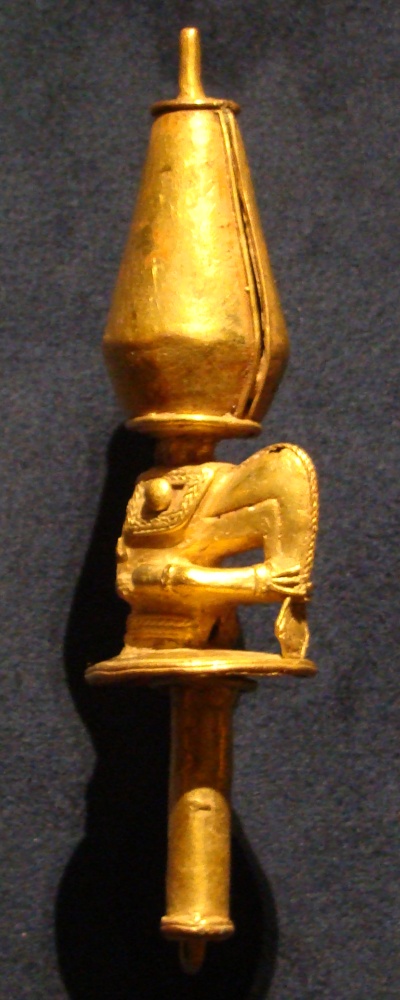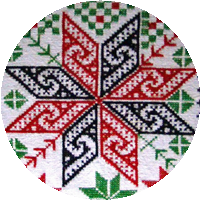Central American Gold
Please click any thumbnail at right for a larger image!
Click any highlighted name to hear its pronunciation!
Gold was one of the earliest and most widely crafted metals in the Americas, with ancient metallurgical traditions spanning from Mexico to South America. Though geographically and culturally at the "periphery" of the Maya, Central American civilizations from Honduras to Colombia had their own distinctive artistic traditions and powerful chiefdoms. Collecting gold from sources among local rivers, the native peoples of Costa Rica and Panama worked the precious metal into pieces of outstanding beauty and spiritual meaning that have survived the centuries.
Much of Central America's gold artifacts were made into personal ornaments for chiefs and shamans, often by the chiefs and shamans themselves. As such, many pieces relate to shamanic themes. The bird in this Diquis pendant from Costa Rica has outlandish wings and miniature limbs in extraordinary microscopic detail Also notice how the four spirals form the ends of small crocodile heads peering from the central bird figure's corners. This combination of animal features could relate to the fusion of human and animal qualities that are experienced in shamanic transformation.
Worcester Art Museum
Both of these staff finials end with bird details, and Boston's Museum of Fine Arts relates them to shamanic experience. For many indigenous cultures worldwide, one of the defining qualities of shamanism is the out-of-body experience in an altered state of consciousness such a dream or a trance. The shaman's soul may feel as if it had transformed into a bird in order to fly into the spirit worlds, to communicate with gods, spirits, and other supernatural beings. They engage with the spirits in order to ensure that they provide health and abundance for the environment and the community. That moment of transformation between bird and shaman could explain the combined features in the creature at left. The bird at right comes from the Sinú River of Colombia.
Museum of Fine Arts
The Coclé of Panama used hammering techniques to produce exquisite masks, jewelry, and pectorals such the one presented here. Many Coclé pectorals portray either pair of symmetric creatures in profile or a central figure with outstretched limbs and supernatural qualities. The big grin this fellow bears is a common element in the pectorals. Based on the large grins I have seen in masks from the Yaqui of northwest Mexico and indigenous societies from other parts of the world, it could represent the power of the supernatural being to protect the wearer against harmful, negative forces. The bizarrely shaped sharks in the upper corners could thus be additional protective spirits.
Museum of Fine Arts
Some of the most marvelous pieces of ancient American gold art comes from the Chiriquí of Panama. (Even the Maya of Chich'én Itzá were so impressed with their quality that they requested it for their funerary offerings!) The wonderful frog at left spews streams in filigree from its mouth, which points to the water symbolism that many native peoples associated with frogs. Some frogs and toads produced hallucinogenic substances that shamans may have used to induce their visionary trances, which could contribute to their sacred quality.
Similar to the Coclé pendant above, the figurine at right bears several menacing faces inspired by the crocodile, and Heidi King suggested that they may have had a related function to protect the wearer against harmful forces. She also described the meticulous details worked into this piece, such as the inset pyrite eyes and chest and the hinge upon which the head could swivel. One last noteworthy detail that I reference from King is the small clapper within the mouth whose sound could have further warded against negative forces.
Metropolitan Museum of Art
A masterpiece of the Central American gold traditions. A man in an elaborate bat mask stands in this fascinating miniature, surrounded by volutes in filigree that could suggest the experience of shamanic flight through the clouds. This image could thus depict the shaman's experience of transformation into the bat. Prominent eyes in the upper crest may therefore relate to the shaman's extended vision in the transformed state. The bat was in fact a powerful animal among the cultures of Colombia and Central America: today's Kogi peoples in Colombia, for example, believe that the bat is a spirit messenger for shamans.
Museum of Fine Arts










